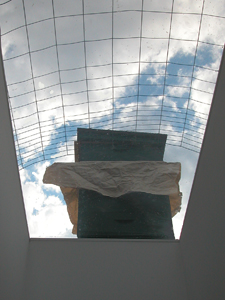 This past week has not been a good one. I have felt out of sorts and worried, all because this does not seem like last Spring, where triumphant life exploded out of two screened boxes full of bees. This is a lower energy year, with mite problems and queen problems and an odd nectar flow, and I am still waiting for that burst of exultation that took me so totally by surprise twelve months ago.
This past week has not been a good one. I have felt out of sorts and worried, all because this does not seem like last Spring, where triumphant life exploded out of two screened boxes full of bees. This is a lower energy year, with mite problems and queen problems and an odd nectar flow, and I am still waiting for that burst of exultation that took me so totally by surprise twelve months ago.It has been six days since the box with young Queen Abigail was placed over the Twain colony, with that sheet of newsprint you see here dividing the new monarch from her foster daughters. For the first three days, nothing happened: looking in quickly, no bees had chewed around the slits I cut in the paper (or even started), and no eggs were present in the Queen's box. The workers were just hanging around, with little flying in or out. Acting queenless.
So I removed two relatively bee-less honey supers off the hive, moved the newspaper sheet down — so the new queen would be directly over the core population of remaining workers — replaced the Queen's box and then the honey supers, and closed the hive up. I was hoping that, by placing her closer, the Eau de Abigail pheromones would be stronger and might get the workers organized. I closed the bottom board, too, to boost concentrations. And I decided to wait three more days before interfering again.
Gets you wondering: exactly which Queen died last week? The imported one or the home-grown princess? If the virgin queen was triumphant, there would be a delay in her laying. And a delay we had. A virgin would have hung around a few days, taken a mating flight, and then started to lay. I have no explanation for why a mated queen would wait. So perhaps Eleanor's genes live on, and the outsider queen died. This does not make me feel better, somehow.
Today was the day to check again (even though I had no plan if I discovered the worst). Inside, there were a few new chew holes in the paper, and new eggs on one frame of comb. Nice laying pattern, too! The bees had filled up most of the rest of the nearby drawn comb with nectar and pollen, so I put a frame of permacomb nearby to give some space for more eggs. Hope that was a good idea!
This means that I need to watch for a few things, and should anticipate a couple of options. First, sometime in about 3-4 days I need to see how those new eggs are capped. If they are all big-domed drone larvae, I have a problem. You see, when you let a virgin queen be raised and mated naturally, she may not mate well or very many times (she may not even survive her flight). She needs to mate anywhere from a couple to a dozen times to get enough sperm to lay her 250,000 lifetime eggs. A queen who has not mated (or mated enough) lays drones.
For the past few days, I have been counting in my head all the known beehives within a three mile radius, and figure where there might be overlaps that promote a Drone Congregating Area (DCA). This is no joke: drone bees hang out together like youths at the gas station/convenience market in a small town. They are sexually mature, have nothing else to do, are anxious to mate, and are hanging out in mobs to identify likely females.
If those eggs turn out to be drone larvae, the Queen is a bust and I get to play executioner again. I would probably wait another week, though, on the off chance that she just got a weird start. If she is a bust, I can either buy another queen, or introduce some really new eggs from the Wilde colony, and let Twain try to raise their own again. Or I can close up shop in that hive for a year, and start over next year. I will probably try to find another queen (and give them some eggs besides).
If those eggs turn out to be worker larvae, however, I'm opening some champagne. I will probably give Twain a frame of Wilde's larvae (to help with the dwindling they have experienced) and feed them like the Dickens all summer long, since they will have missed out on the nectar flow. The colony that was gangbusters last year will be the dependent one this year.
But this story does not have an ending yet, and every time there is an ending some question arises to draw uncertainty and suspense along, like an insect serial drama.
If I do get to pop that cork, my first toast will be to bee years that are good for all one's buzzing communities, and that 2007 will be one of those.
1 comment:
It's a curious observation you have concerning last year's high energy and this year's lower energy. I've seen the same kind of thing concerning swarms, swarmed hives and swarm prevented hives.
Disease and overall bee health can have an effect. But could there be something we beekeepers do that might confound the natural high energy rhythme of the bee?
I think so.
Regards
BWrangler
PS-Neat Blog, I check it every week.
Post a Comment